A Flat Major 7 Piano
A-flat modest-major 7th chord
The Solution below shows the A-apartment pocket-sized-major seventh chord in root position, 1st, 2nd, and 3rd inversions, on the piano, treble clef and bass clef.
The Lesson steps then explain how to construct this 7th chord using the tertiary, fifth and 7th annotation intervals, and so finally how to construct the inverted chord variations.
For a quick summary of this topic, have a look at 7th chord.
| Primal | C | C# | Db | D | D# | Eb | Due east | E# | Fb | F | F# | Gb | G | 1000# | [Ab] | A | A# | Bb | B | B# | Cb |
|---|
Solution - 4 parts
i. A-flat modest-major 7th chord
This step shows the A-flat minor-major 7th chord in root position on the piano, treble clef and bass clef.
The A-apartment minor-major 7th chord contains 4 notes: Ab, Cb, Eb, M.
The chord spelling / formula relative to the Ab major calibration is:1 b3 5 seven.
| Note no. | Note interval | Spelling / formula | Note name | #Semitones from root |
|---|---|---|---|---|
| i | root | 1 | The 1st annotation of the A-flat pocket-size-major 7th chord is Ab | 0 |
| 2 | Ab-min-3rd | b3 | The 2nd note of the A-apartment minor-major 7th chord is Cb | three |
| three | Ab-perf-5th | 5 | The 3rd annotation of the A-flat small-scale-major seventh chord is Eb | seven |
| 4 | Ab-maj-7th | 7 | The quaternary annotation of the A-flat minor-major 7th chord is Chiliad | xi |
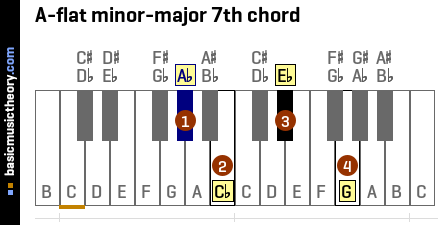
Centre C (midi note 60) is shown with an orange line under the 2d notation on the pianoforte diagram.
These note names are shown below on the treble clef followed by the bass clef.
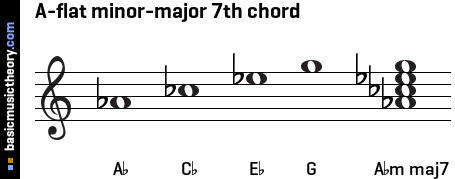
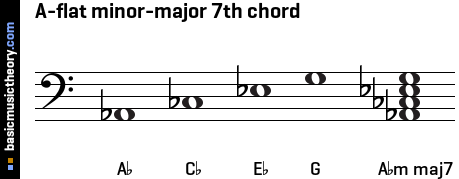
The figured bass symbols for this chord in root position are vii/v/3.
The staff diagrams and audio files contain each note individually, ascending from the root, followed by the chord containing all three notes.
| | Bass Clef: | Midi | MP3 | | Treble Clef: | Midi | MP3 |
2. A-flat minor-major 7th 1st inversion
This step shows the A-flat minor-major 7th 1st inversion on the piano, treble clef and bass clef.
The A-flat pocket-sized-major 7th 1st inversion contains iv notes: Cb, Eb, G, Ab.
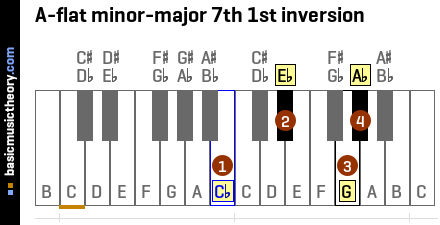
These note names are shown below on the treble clef followed by the bass clef.
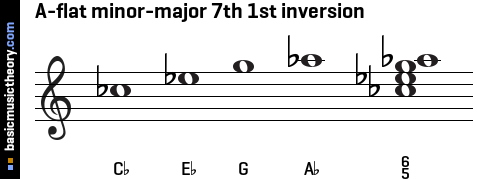
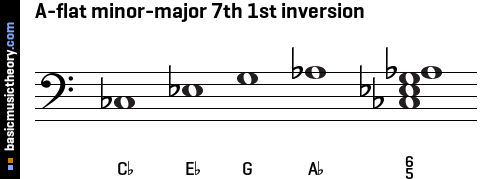
The figured bass symbols for this chord in root position are 6/five/3, then the chord is said to be in six-five-three position.
| | Bass Clef: | Midi | MP3 | | Treble Clef: | Midi | MP3 |
3. A-flat minor-major 7th 2nd inversion
This step shows the A-flat pocket-size-major 7th 2d inversion on the piano, treble clef and bass clef.
The A-flat modest-major 7th 2nd inversion contains 4 notes: Eb, Thou, Ab, Cb.
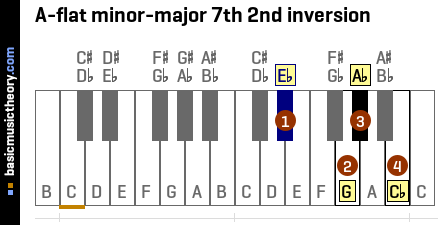
These note names are shown beneath on the treble clef followed past the bass clef.
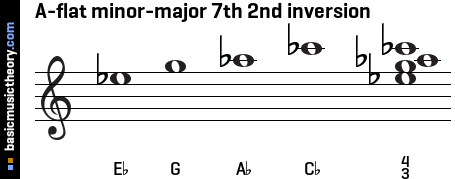

The figured bass symbols for this chord in root position are 6/4/3, so the chord is said to exist in six-four-iii position.
| | Bass Clef: | Midi | MP3 | | Treble Clef: | Midi | MP3 |
4. A-flat pocket-sized-major 7th 3rd inversion
This step shows the A-apartment small-scale-major 7th tertiary inversion on the pianoforte, treble clef and bass clef.
The A-apartment minor-major 7th 3rd inversion contains 4 notes: Chiliad, Ab, Cb, Eb.
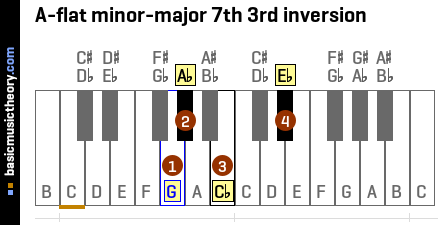
These note names are shown below on the treble clef followed past the bass clef.
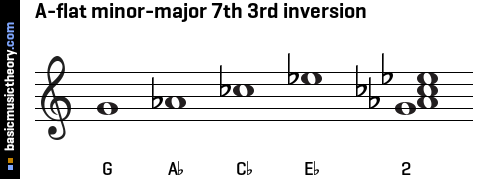
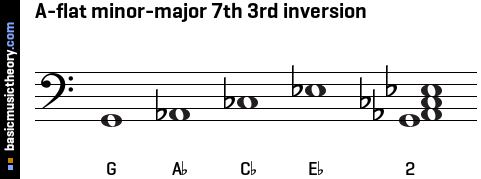
The figured bass symbols for this chord in root position are 6/4/two, and so the chord is said to be in six-4-2 position.
| | Bass Clef: | Midi | MP3 | | Treble Clef: | Midi | MP3 |
Lesson steps
1. Piano central note names
This pace shows the white and black note names on a piano keyboard so that the note names are familiar for subsequently steps, and to show that the notation names start repeating themselves after 12 notes.
The white keys are named using the alphabetic letters A, B, C, D, Eastward, F, and Thousand, which is a blueprint that repeats upward the piano keyboard.
Every white or black central could have a flat(b) or abrupt(#) accidental proper noun, depending on how that note is used. In a later footstep, if sharp or apartment notes are used, the exact accidental names volition be called.
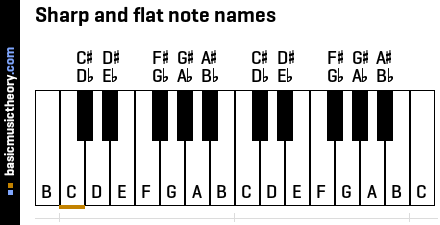
The audio files beneath play every note shown on the piano in a higher place, so middle C (marked with an orangish line at the bottom) is the 2nd note heard.
| | Bass Clef: | Midi | MP3 | | Treble Clef: | Midi | MP3 |
two. A-flat tonic note and one octave of notes
This step shows 1 octave of notes starting from note Ab, to identify the start and end notes of the scale used to build this chord.
The numbered notes are those that might exist used when building this chord.
Note 1 is the root note - the starting notation of the chord - Ab, and note 13 is the same note name just i octave higher.
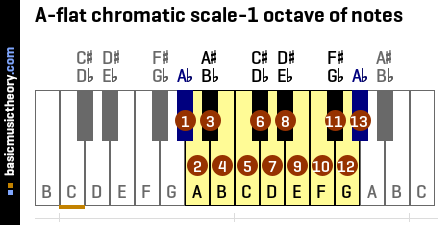
| No. | i | 2 | 3 | iv | 5 | 6 | 7 | 8 | nine | ten | 11 | 12 | 13 |
|---|---|---|---|---|---|---|---|---|---|---|---|---|---|
| Note | Ab | A | A# / Bb | B | C | C# / Db | D | D# / Eb | E | F | F# / Gb | G | Ab |
| | Bass Clef: | Midi | MP3 | | Treble Clef: | Midi | MP3 |
iii. A-apartment major scale annotation interval positions
This stride describes the Ab major scale , whose note intervals are used to define the chord in a later on pace.
The major scale uses the West-W-H-W-West-Due west-H annotation counting rule to identify the scale note positions.
To count up a Wpigsty tone, count up by two physical pianoforte keys, either white or black.
To count up a Half-tone (semitone), count upwards from the last note upwards by i concrete piano cardinal, either white or black.
The tonic note (shown as *) is the starting point and is always the 1st note in the major scale.
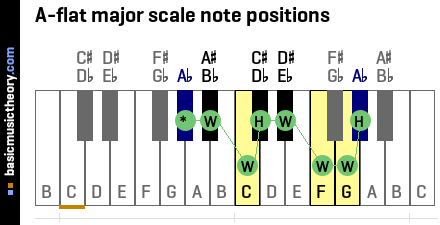
Once more, the final eighth annotation is the octave note, having the same proper noun as the tonic note.
| No. | 1 | 2 | three | iv | 5 | six | seven | 8 |
|---|---|---|---|---|---|---|---|---|
| Note | Ab | A# / Bb | C | C# / Db | D# / Eb | F | Thou | Ab |
| | Bass Clef: | Midi | MP3 | | Treble Clef: | Midi | MP3 |
4. A-flat major scale notation interval numbers
This footstep identifies the note interval numbers of each scale annotation, which are used to summate the chord note names in a later step.
To identify the notation interval numbers for this major calibration, but assign each note position from the previous step, with numbers ascending from 1 to eight.
| No. | 1 | ii | 3 | 4 | five | 6 | 7 | viii |
|---|---|---|---|---|---|---|---|---|
| Annotation | Ab | Bb | C | Db | Eb | F | G | Ab |
To understand why the note names of this major calibration have these specific sharp and apartment names, have a wait at the Ab major scale folio.

Both the note interval numbers and note names from the pianoforte diagram above volition be used in later steps to calculate the chord note names.
5. 7th chord qualities
This step defines a 7th chord, names the 7th chord qualities and identifies the notes that vary between them.
seventh chord definition
Whereas a triad chord contains 3 notes, a 7th chord contains four notes that are played together or overlapping.
7th chord qualities
7th chords exist in eight different chord qualities, which are diminished, half-macerated, minor, minor-major , dominant, major, augmented, and augmented-major.
Each chord quality name is the proper noun of the entire chord equally a whole, non its individual notes (which will be covered afterward).
Triad chord qualities using the 1st, 3rd, 5th and seventh scale notes
All of these 7th chord qualities are based on the 1st, 3rd, 5th and 7th notes of the major scale pianoforte diagram to a higher place.
Depending on the chord quality, the 3rd, 5th and 7th scale note names of the major scale above might demand to exist adapted up or downwards by one or more than half-notes / semitones / piano keys.
It is these variations of the tertiary, fifth and 7th notes that requite each one a distinctive audio for whatever given key (eg. C-flat, E etc).
In fact, these seventh chords are based on triad chords - the first 3 notes of whatsoever 7th chord are identical to a specific triad chord quality, with one extra note added to brand information technology a 7th chord.
Suspended seventh chords - using the second or fourth scale notes
A suspended chord is known in music theory as an altered chord because information technology takes i of the higher up chord qualities and modifies it in some manner.
Dissimilar all of the to a higher place qualities, Suspended triad chords do not use the tertiary annotation of the major scale (at all) to build the chord.
The 3rd note is suspended, ie. removed completely, and replaced by either the 2d note of the major scale - a suspended 2nd, or more than unremarkably by the quaternary note of the major calibration - a suspended 4th.
Musically, this is interesting, since it is unremarkably the 3rd notation of the calibration that defines the overall character of the chord as beingness major (typically described as 'happy') or minor ('sad').
Without this tertiary note, suspended chords tend to accept an open and cryptic sound.
The steps below will detail the minor-major 7th triad chord quality in the key of Ab.
6. 7th chord note intervals
This step defines the note intervals for each chord quality, including the intervals for the A-flat small-major 7th seventh chord. It also shows how the 7th chord qualities are related to the triad chord qualities they are based on.
Each individual note in a 7th chord tin can exist represented in music theory using a note interval, which is used to limited the relationship between the first note of the chord (the root note), and the note in question.
The root annotation is always the 1st note (note interval one in the above diagram) of the major scale diagram above. ie. the tonic of the major scale.
And so there is one note interval to describe the 2nd annotation, and some other to describe the 3rd annotation of the chord, and finally another interval for the 4th chord annotation.
In the same way that the entire chord itself has a chord quality, the intervals representing the individual notes within that chord each have their own quality.
These notation interval qualities are macerated, pocket-sized, major, perfect and augmented.
Below is a table showing the note interval qualities for all 7th chords, together with the interval short names / abbrevations in brackets.
The final cavalcade shows the triad chord quality that the 7th chord is based on, and then the second and third notation quality columns are the same as the triad table for the same primal.
| 7th chord quality | 2nd annotation quality | 3rd annotation quality | fourth notation quality | Based on triad quality |
|---|---|---|---|---|
| diminished | small-scale (m3) | macerated (d5) | diminished (d7) | diminished |
| half-diminished | small-scale (m3) | diminished (d5) | minor (m7) | diminished |
| pocket-sized | pocket-sized (m3) | perfect (P5) | small (m7) | minor |
| minor major | minor (m3) | perfect (P5) | major (M7) | minor |
| ascendant | major (M3) | perfect (P5) | minor (m7) | major |
| major | major (M3) | perfect (P5) | major (M7) | major |
| augmented | major (M3) | augmented (A5) | minor (m7) | augmented |
| augmented-major | major (M3) | augmented (A5) | major (M7) | augmented |
| major suspended (second/4th) | major (M2) or perfect (P4) | perfect (P5) | major (M7) | suspended (2nd/4th) |
| dominant suspended quaternary | perfect (P4) | perfect (P5) | minor (m7) | suspended fourth |
The numbers in brackets are the notation interval number (ie the scale annotation number) shown in the previous step.
Looking at the table above, the note intervals for the chord quality we are interested in (minor-major 7th), in the cardinal of Ab are Ab-min-3rd, Ab-perf-5th, and Ab-maj-7th.
The links above explain in detail the pregnant of these qualities, the brusque abbrevations in brackets, and how to calculate the interval note names based on the scale notation names from the previous step.
7. A-flat pocket-sized-major 7th chord in root position
This step shows the A-flat small-scale-major seventh chord note interval names and note positions on a piano diagram.
Note name adjustments
Each note interval quality (diminished, minor, major, perfect, augmented) expresses a possible aligning ie. a possible increase or decrease in the note pitch from the major calibration notes in step 4.
If an adjustment in the pitch occurs, the note name given in the major scale in step 4 is modified, so that sharp or apartment accidentals volition be added or removed.
But crucially, for all interval qualities, the starting point from which accidentals need to be added or removed are the major scale notation names in step 4.
For this chord, this is explained in detail in Ab-min-tertiary, Ab-perf-5th and Ab-maj-7th, but the relevant adjustments for this minor-major seventh chord quality are shown below:
Ab-3rd: The tertiary note quality of the major calibration is major, and the note interval quality needed is small-scale, and then the 3rd note scale note proper name - C, is adjusted i half-annotation / semitone down to Cb. The chord note spelling reflects this annotation flattening: b3.
Ab-5th: Since the 5th notation quality of the major scale is perfect, and the note interval quality needed is perfect also, no adjustment needs to exist made. The fifth annotation proper name - Eb is used, and the chord notation spelling is 5.
Ab-7th: Since the 7th note quality of the major calibration is major, and the note interval quality needed is major as well, no adjustment needs to be made. The seventh note name - Thou is used, and the chord note spelling is 7.
If information technology is withal not clear why the interval qualities are organised / related as they are, please refer to each of the interval links above.
A-flat pocket-size-major 7th seventh chord note names
The terminal chord annotation names and note interval links are shown in the table below.
| Annotation | 1 | 3 | five | 7 |
|---|---|---|---|---|
| Interval No. | Ab | Cb | Eb | G |
| Interval def | root | Ab-min-3rd | Ab-perf-5th | Ab-maj-seventh |
| Spelling | 1 | b3 | 5 | seven |
| #Semitones | 0 | 3 | 7 | eleven |
The piano diagram beneath shows the interval brusk names, the note positions and the terminal note names of this triad chord.
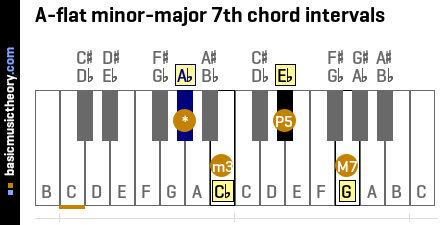
In music theory, this 7th chord equally it stands is said to be in root position because the root of the chord - note Ab, is the note with the everyman pitch of all the chord notes.
The note guild of this chord can also be inverse, so that the root is no longer the lowest note, in which case the chord is no longer in root position, and will be called an inverted seventh chord instead.
For seventh chords, in that location are iii possible inverted variations as described below.
Figured bass notation
The figured bass annotation for a 7th chord in root position is 7/5/3, with the 7 placed above the 5, and the 5 above the 3.
These numbers represent the interval between the everyman note of the chord and the note in question.
So another name for this inversion would be A-flat minor-major 7th triad in 7-five-three position.
For example, the 7 represents note G, from the Ab-seventh interval, since the chord root, Ab, is the lowest notation of the chord (as it is not inverted). .
In the same way, the figured bass 5 symbol represents note Eb, from the Ab-5th interval, and the 3 symbol represents notation Cb, from the Ab-3rd interval
Since figured bass note works within the context of a key, we don't demand to bespeak in the figured bass symbols whether eg. the tertiary is a major, minor etc. The key is assumed from the key signature.
Often, for a 7th chord in root position, simply the 7 symbol is shown, since information technology is assumed that the chord is shown in root position (ie non inverted), unless otherwise indicated equally shown below.
| | Bass Clef: | Midi | MP3 | | Treble Clef: | Midi | MP3 |
viii. A-flat minor-major 7th 1st inversion
This pace shows the first inversion of the A-flat pocket-sized-major 7th.
To invert a chord, just take the commencement note of the chord to be inverted (the everyman in pitch) and move it up an octave to the terminate of the chord.
So for a 1st inversion, accept the root of the seventh chord in root position from the stride above - note Ab, and move information technology upward one octave (12 notes) so information technology is the last (highest) annotation in the chord.
The 2nd note of the original 7th chord (in root position) - annotation Cb is at present the notation with the lowest pitch.

Figured bass note
The figured bass notation for this chord in 1st inversion is 6/5/3, with the vi placed above the 5, and the five placed above the 3 on a staff diagram.
Based on this numbering scheme, another proper name for this inversion would be A-apartment minor-major 7th triad in half-dozen-five-iii position.
These numbers represent the interval betwixt the lowest notation of the chord (not necessarily the original chord root!), and the note in question.
For case, the 6 represents notation Ab, from the Cb-sixth interval, since the lowest (bass) note of the chord - now inverted, is Cb.
In the same way, the figured bass 5 symbol represents note G, from the Cb-5th interval, and the iii symbol represents note Eb, from the Cb-third interval
In 1st inversion, often the 3 symbol is not shown at all, as it is assumed.
| | Bass Clef: | Midi | MP3 | | Treble Clef: | Midi | MP3 |
9. A-apartment minor-major 7th 2nd inversion
This footstep shows the 2nd inversion of the A-flat minor-major 7th.
For a 2nd inversion, take the first note of the 1st inversion above - Cb, and movement it to the end of the chord.
Then the second note of the 1st inversion - note Eb is now the annotation with the everyman pitch for the 2d inversion.
Or put another way, the third note of the original 7th chord (in root position) is now the note with the everyman pitch.

Figured bass notation
The figured bass notation for this chord in 2nd inversion is 6/4/3, with the 6 placed above the 4, and the iv placed higher up the 3 on a staff diagram.
Based on this numbering scheme, some other proper name for this inversion would exist A-flat minor-major 7th triad in vi-four-three position.
These numbers represent the interval between the lowest note of the chord (not necessarily the original chord root!), and the note in question.
For example, the half dozen represents annotation Cb, from the Eb-6th interval, since the lowest (bass) note of the chord - now inverted, is Eb.
In the aforementioned way, the figured bass 4 symbol represents note Ab, from the Eb-4th interval, and the 3 symbol represents annotation Grand, from the Eb-tertiary interval
In 2nd inversion, often the vi symbol is not shown at all, as it is causeless.
| | Bass Clef: | Midi | MP3 | | Treble Clef: | Midi | MP3 |
10. A-flat minor-major 7th tertiary inversion
This step shows the third inversion of the A-apartment pocket-size-major 7th.
For a 3rd inversion, take the get-go annotation of the 2nd inversion above - Eb, and motion it to the end of the chord.
So the second notation of the 2nd inversion - annotation G is now the note with the lowest pitch for the 3rd inversion.
Or put another mode, the fourth note of the original 7th chord (in root position) is now the annotation with the lowest pitch.

Figured bass notation
The figured bass notation for this chord in third inversion is 6/4/2, with the 6 placed above the iv, and the 4 placed in a higher place the 2 on a staff diagram.
Based on this numbering scheme, another name for this inversion would be A-flat modest-major 7th triad in six-four-ii position.
These numbers represent the interval between the lowest note of the chord (non necessarily the original chord root!), and the notation in question.
For example, the 6 represents note Eb, from the G-sixth interval, since the everyman (bass) note of the chord - at present inverted, is G.
In the same way, the figured bass iv symbol represents note Cb, from the Grand-4th interval, and the 2 symbol represents annotation Ab, from the Yard-2nd interval
In third inversion, oft the six symbol is not shown at all, as it is causeless.
| | Bass Clef: | Midi | MP3 | | Treble Clef: | Midi | MP3 |
| Cardinal | C | C# | Db | D | D# | Eb | Due east | E# | Fb | F | F# | Gb | G | G# | [Ab] | A | A# | Bb | B | B# | Cb |
|---|
| Related links | A-flat minor-major 7th chord , Ab, Ab natural small scale, Ab major scale |
|---|---|
| Minor scales | Ab harmonic pocket-size calibration, Ab melodic minor scale |
| More than scales | Ab chromatic scale, Ab major pentatonic scale, Ab small pentatonic scale |
| Intervals | Ab-1st, Ab-2nd, Ab-third, Ab-4th, Ab-5th, Ab-sixth, Ab-7th, Ab-8th |
| Circumvolve of 5ths | Larn the circle of fifths, Ab major on circumvolve of 5ths |
| Modes | Ab ionian, Ab dorian, Ab phrygian, Ab lydian, Ab mixolydian, Ab aeolian, Ab locrian |
| Triad chords | Ab diminished, Ab minor, Ab major, Ab augmented, Ab suspended 2nd, Ab suspended 4th |
| sixth chords | Ab pocket-sized 6th, Ab major 6th |
| 7th chords | Ab dim 7, Ab half-dim7, Ab min 7,Ab min-maj seven, Ab dom 7, Ab maj 7, Ab aug 7, Ab aug-maj 7, Ab maj 7 sus2, Ab dom seven sus4, Ab maj seven sus4 |
| Scale triad chords | Ab major triad chords, Ab minor triad chords, Ab harmonic minor chords, Ab melodic minor chords |
| Scale 7th chords | Ab major 7th chords, Ab small-scale 7th chords, Ab harmonic modest 7th chords, Ab melodic small 7th chords |
| Triad modes | Ab ionian, Ab dorian, Ab phrygian, Ab lydian, Ab mixolydian, Ab aeolian, Ab locrian |
| 7th modes | ionian, C dorian, C phrygian, C lydian, C mixolydian, C aeolian, C locrian |
| Cadences | C major perfect authentic, C major imperfect authentic, C major plagal, C major half, C major deceptive |
A Flat Major 7 Piano,
Source: https://www.basicmusictheory.com/a-flat-minor-major-7th-chord
Posted by: lynnantither.blogspot.com


0 Response to "A Flat Major 7 Piano"
Post a Comment